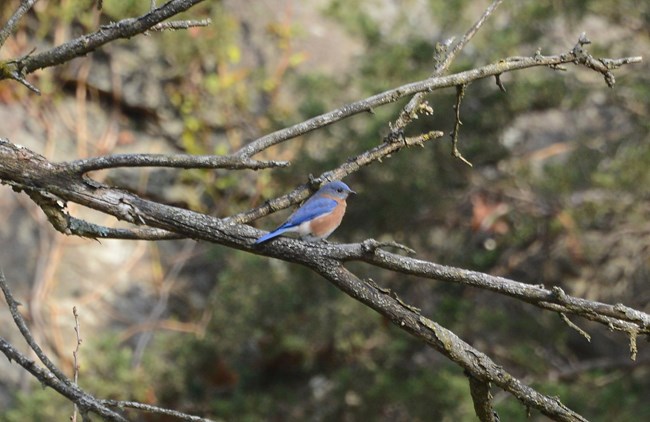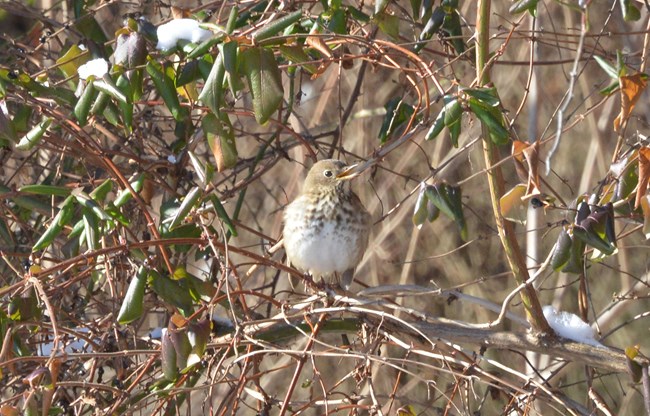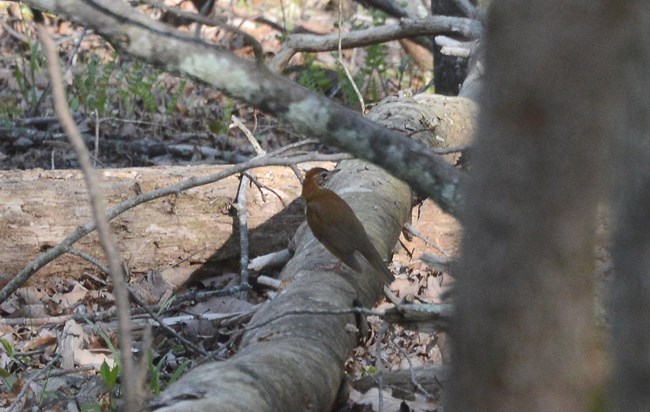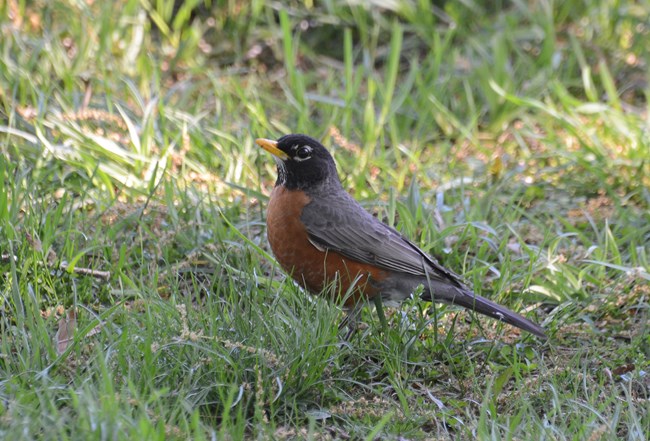|
NPS.gov / Park Home / Learn About the Park / Nature / Animals / Birds / Perching Birds
Thrushes are usually brown, blue, gray, or often a blend of colors. They mainly eat fruit and insects, but also like to eat seeds, leaves, and worms. This family of birds likes to forage (look for food) on the ground, searching the soil, leaf litter, and vegetation for prey. Thrushes are found worldwide except for Antarctica and other parts of the Arctic.

© Bill Telfair Eastern Bluebird (Sialia sialis)• Eastern Bluebirds live in meadows and various spots that they consider suitable for nesting sites such as old woodpecker holes or nesting boxes.• Bluebirds mostly like to eat insects they catch on the ground like caterpillars, beetles, crickets, grasshoppers, and spiders. In the fall/winter they eat a lot of fruits like blueberries, wild holly, honeysuckle, mistletoe, and more. • They have really good eyesight and can see their small prey from 60 or more feet away! • Identification Information:• Size: Bigger than a Sparrow, but smaller than a Robin (Small)• Color: Males are a vivid deep blue and have a rusty/ brick red belly. Females are gray with bluish wings and tail and they have a lighter orange brown belly 
© Bill Telfair Hermit Thrush (Catharus gattatus)• Hermit Thrushes sometimes get creative with their nest placement. Nests have been found on cemetery graves, on golf courses, and in mine shafts. Normally their nests are in/around trees and shrubs.• Sometimes Hermit Thrushes forage by “foot quivering”. They do this by shaking bits of grass with their feet to get the insects in the grass. • They love to eat insects such as beetles, caterpillars, bees, ants, wasps, and flies but they will also sometimes eat small amphibians and reptiles. • During a courtship display, male Hermit Thrushes will chase the female in circles after one or two days the pair will finally develop a slower flying pattern. Identification Information• Size: Between a sparrow and a robin (Small/Medium)• Color: Hermit Thrushes are a rich brown on their head and on the back of their bodies with a reddish/brown tail. Their bellies are an offwhite with distinct brown spots on their throat. The lower down the spots go, the more smudged they look. 
© Bill Telfair Wood Thrush (Hylocichla mustelina)• When Wood Thrush males compete for mates by singing, they answer a rivals song by singing a completely different song. In most songbird species competing males sing the same song.• Wood Thrushes are very talented singers and they can sing duets with themselves by doing unique things with their voice box. • These birds are vulnerable to nest parasitism by other birds especially Brown-headed Cowbirds. This means that other birds lay their eggs in other birds nest and some birds take care of them as if they were their own. • Wood Thrushes are one of the first songbirds to be heard in the morning and one of the last to be heard in the evening. • They love to eat insects that live in leaf-litter like beetles, flies, caterpillars, spiders, etc. and also like to eat fruit from shrubs like blueberry, spicebush, and elderberry. Identification Information• Size: Between a sparrow and a robin (Small/Medium)• Color: Wood Thrushes are a reddish/brown on their back with a white belly with brown/black spots as well. They also have a bold, white ring around their eyes. Young Wood Thrushes look very similar to adults but their overall coloring is muted and duller. 
© Bill Telfair American Robin (Turdus migratorius)• Robins eat different kinds of food depending on what time of day it is. They eat more earthworms in the morning and more fruit later in the day. They are birds known for the phrase “the early bird gets the worm”.• Because robins eat a lot of their food on lawns, they are vulnerable to pesticide poisons and can be an important indicator of chemical pollution and its effects. • American Robins usually find worms by staring at the ground with their head cocked to one side and they sometimes fight other robins over worms. • In springtime, male robins attract females by singing, raising and spreading their tails, shaking their wings, and inflating their throats. When a pair has formed they display by the male and female approaching each other while holding their bills wide open and touching them. Identification Information• Size: Robin sized (Small/Medium)• Color: American Robins are gray/brown birds with orangish/brown bellies with a dark head. Females have similar coloring but they have paler heads.
All of the above information is an abbreviated version of information gathered from the Cornell Lab of Ornithology. Please visit their website for more in-depth bird information.
|
Last updated: September 13, 2019
